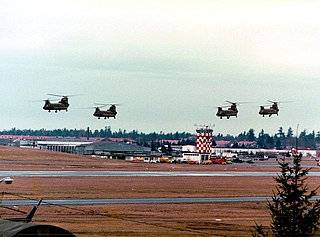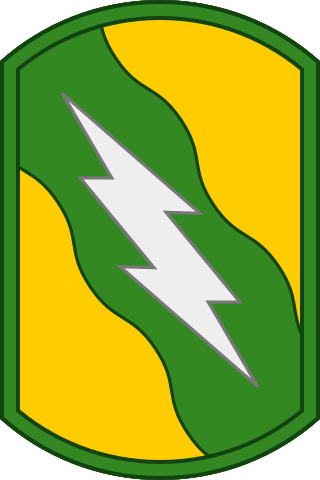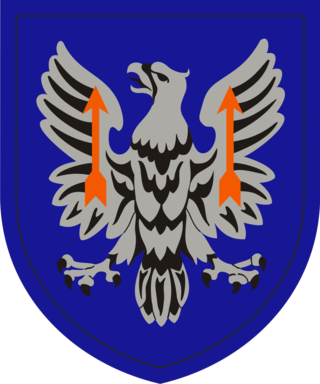
The 1st Infantry Division (1ID) is a combined arms division of the United States Army, and is the oldest continuously serving division in the Regular Army. It has seen continuous service since its organization in 1917 during World War I. It was officially nicknamed "The Big Red One" after its shoulder patch and is also nicknamed "The Fighting First." The division has also received troop monikers of "The Big Dead One" and "The Bloody First" as puns on the respective officially sanctioned nicknames. It is currently based at Fort Riley, Kansas.

The 4th Infantry Division is a division of the United States Army based at Fort Carson, Colorado. It is composed of a division headquarters battalion, three brigade combat teams, a combat aviation brigade, a division sustainment brigade, and a division artillery.

The 28th Infantry Division ("Keystone") is a unit of the Army National Guard and is the oldest division-sized unit in the Department of Defense. Some of the units of the division can trace their lineage to Benjamin Franklin's battalion, The Pennsylvania Associators (1747–1777). The division was officially established in 1879 and was later redesignated as the 28th Division in 1917, after the entry of America into the First World War. It is today part of the Pennsylvania Army National Guard, Maryland Army National Guard, Ohio Army National Guard, and New Jersey Army National Guard.

The 8th Infantry Regiment of the United States, also known as the "Fighting Eagles," is an infantry regiment in the United States Army. The 8th Infantry participated in the Mexican War, American Civil War, Philippine Insurrection, Moro Rebellion, World War I, World War II, Vietnam War, and Iraq Campaign.

Gray Army Airfield, also known as Gray AAF, is a military airfield located within Joint Base Lewis–McChord near Tacoma, in Pierce County, Washington, United States.

The New York Army National Guard is a component of the New York National Guard and the Army National Guard. Nationwide, the Army National Guard comprises approximately one half of the United States Army's available combat forces and approximately one third of its support organization. National coordination of various state National Guard units are maintained through the National Guard Bureau.

The Pennsylvania Army National Guard, abbreviated PAARNG, is part of the United States Army National Guard and is based in the U.S. Commonwealth of Pennsylvania. Together with the Pennsylvania Air National Guard, it is directed by the Pennsylvania Department of Military and Veterans Affairs. The PAARNG maintains 124 armories and is present in 87 communities across the Commonwealth.

Below is an estimated list of the major units deployed within the Multi-National Force – Iraq and other United States military units that were operating in Iraq under the U.S. Central Command (USCENTCOM) in 2009, during the Iraq War.

The 256th Infantry Brigade Combat Team is a modular infantry brigade combat team (IBCT) of the Louisiana Army National Guard. It is headquartered in Lafayette, Louisiana. Currently the brigade is part of the 36th Infantry Division of the Texas Army National Guard.

The Combat Aviation Brigade, 1st Infantry Division is the Army Aviation formation of the United States Army's 1st Infantry Division. The current commander of this brigade is Colonel Chad P. Corrigan.

Camp Taji, also known as Camp Cooke, is a military installation used by Iraqi and Coalition forces near Taji, Baghdad Governorate, Iraq. The camp is located in a rural region approximately 27 km (17 mi) north of the capital Baghdad.
The Special Troops Battalion, 3rd Brigade Combat Team, 101st Airborne Division, Fort Campbell, Kentucky, was a multi-functional battalion created on 16 September 2004 as part of the U.S. Army's brigade realignment plan to transform brigades into units of action (UA). It brought together a combat engineer company from the 326th Engineer Battalion (Combat) (Airborne) and signal and military intelligence companies formerly affiliated with inactivated battalions in the 101st Airborne Division. Although one former member of the battalion recalled that the Rakkasans were "almost like a cult in every sense," the battalion itself was largely an administrative entity rather than a cohesive operational unit. With disparate roles, its component units operated separately outside of garrison, supporting maneuver battalions or the brigade itself during training and deployments.

The 3rd Brigade Combat Team, 1st Cavalry Division is a combined arms armored brigade of the 1st Cavalry Division based in Fort Cavazos, TX. Major equipment includes the M1A2SEP Tanks, M2A3 & M3A3 Bradley infantry fighting vehicles, M109A7 Paladin howitzers, and M1114 up-armored Humvees.
In 2009, the United States and NATO International Security Assistance Force (ISAF) coalition, along with Afghan National Army forces, continued military operations against the Taliban in Afghanistan. 2009 marks the eighth year of the War in Afghanistan, which began late in 2001. And 75th ranger regiment is also in Afghanistan as of 2018

The 155th Armored Brigade Combat Team is a brigade combat team of the Mississippi Army National Guard.

The Combat Aviation Brigade, 101st Airborne Division is a Combat Aviation Brigade (CAB) of the United States Army. It was first organized in July 1968 as an aviation group and stands as the most decorated aviation unit in the United States Army. It was redesignated an aviation brigade in 1986. It has served in almost every single military operation since the Vietnam War. In support of the Global War on Terror, the CAB has distinguished itself as the military's premiere combat aviation unit during its two deployments to Iraq and five deployments to Afghanistan. The brigade has flown hundreds of thousands of hours during these combat tours, transporting millions of troops around the battlefield and providing close air support/aerial reconnaissance. The 101st broke its own record for longest air assault in history during the invasion of Iraq in 2003. Previously, the longest air assault was conducted in 1991 during Operation Desert Storm.

The 11th Expeditionary Combat Aviation Brigade is a Combat Aviation Brigade in the United States Army Reserve. The unit's lineage can be traced to the prior lineage and insignia of the 11th Aviation Group which was last headquartered in Illesheim, Germany in 2005. It is one of two aviation brigades of Army Reserve Aviation Command. The brigade consists of a headquarters company, two Black Hawk assault battalions, and one fixed wing battalion. The brigade was activated in its current formation on 16 September 2016.

The Kentucky Army National Guard is a component of the United States Army and the United States National Guard. Nationwide, the Army National Guard comprises approximately one half of the US Army's available combat forces and approximately one third of its support organization. National coordination of various state National Guard units are maintained through the National Guard Bureau.

The 1st Aviation Regiment is a task force and is a unit in the First Infantry Division's Combat Aviation Brigade, composed of three battalion units of pilots, crews, and teams within the United States Army.

The 3rd Aviation Regiment is a regiment of the United States Army Aviation Branch. It operates the Boeing AH-64 Apache attack helicopter, Sikorsky UH-60 Black Hawk helicopter, and Boeing CH-47 Chinook helicopter. It has been associated with the 3rd Infantry Division for some time.





















